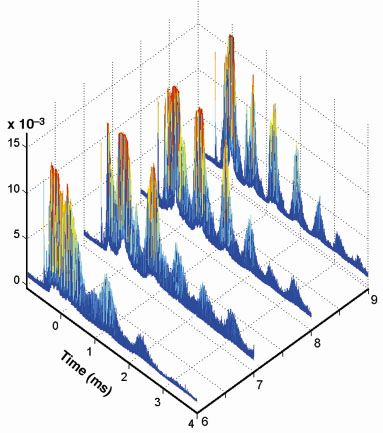- Home
- Users & Science
- Scientific Documentation
- ESRF Highlights
- ESRF Highlights 2001
- The X-ray Source
- Time-resolved Beam Loss Detection
Time-resolved Beam Loss Detection
The existing beam loss detectors have been adapted in order to resolve in time, turn by turn, the rate of electron loss following the injection process. The time-resolved study of the losses following injection allows the study of the mechanism of different loss processes. An understanding of the significance of the different loss processes is important in order to improve the overall efficiency and to control the radiation dose produced during the injection.
The electrons lost during the injection process are detected via the shower of secondary particles created due to their passage through the vacuum chamber and the magnet blocks. This secondary radiation scattered towards the inside wall of the tunnel causes scintillation in a 60 cm long by 25 mm diameter Perspex rod. The visible light so produced is guided towards a photo multiplier tube at one end. The whole apparatus is protected from synchrotron radiation and stray light by a 1 cm thick lead tube. The signal from the anode can then be coupled directly into a 50 ohm cable and viewed on an oscilloscope in the control room. Typical signals received after the cell 6 scraper are shown in Figure 190. With this diagnostic system we were able to distinguish for the first time, losses from the end of the transfer line, losses due to transverse phase space acceptance and also due to the longitudinal capture process. Intense losses are seen during the first tens of turns due to the large horizontal betatron oscillation of the beam followed by distributed losses over several hundred turns due to the longitudinal dynamics of the injected beam. By looking just at the losses when exiting the TL2 transfer line, we see that they account for a 1% loss of the beam and the size of the beam was determined to be 1 mm FWHM. The fact that the injection losses extend over many synchrotron periods was at first puzzling, but has since also been observed at other light sources such as BESSY II.
 |
Fig. 190: Electron losses versus time during injection for different accelerating RF voltages. The full time window is 4 ms. |



